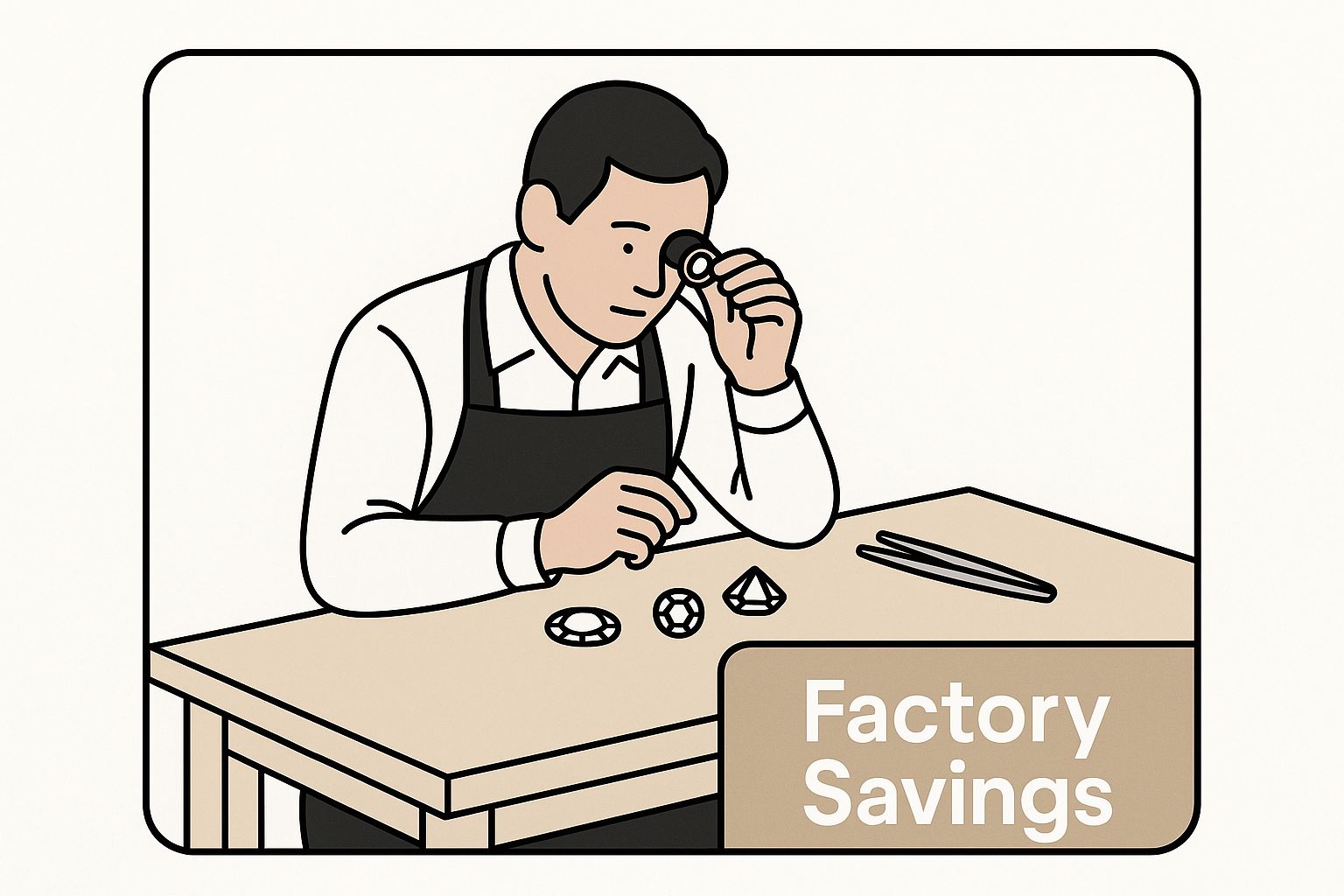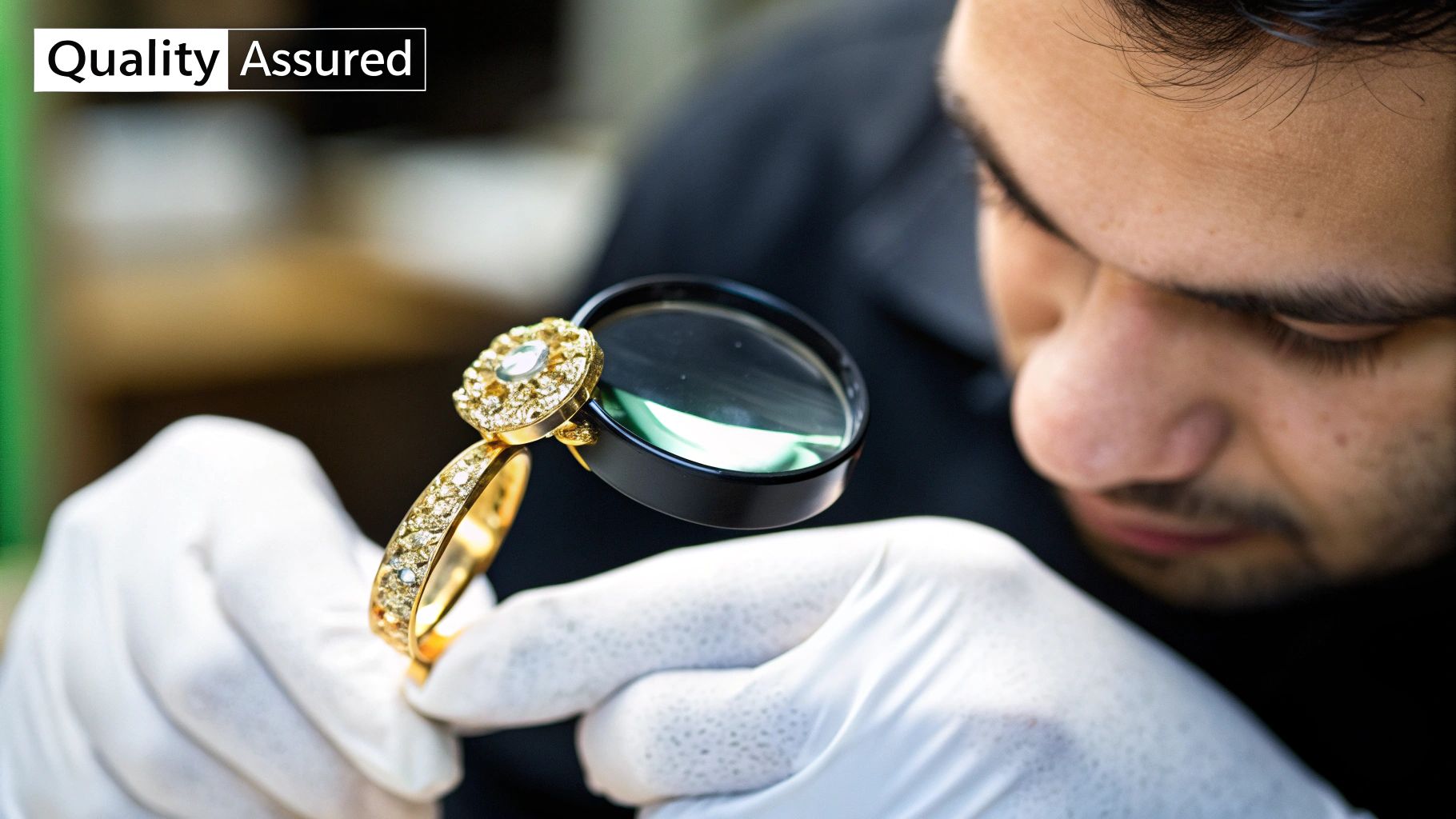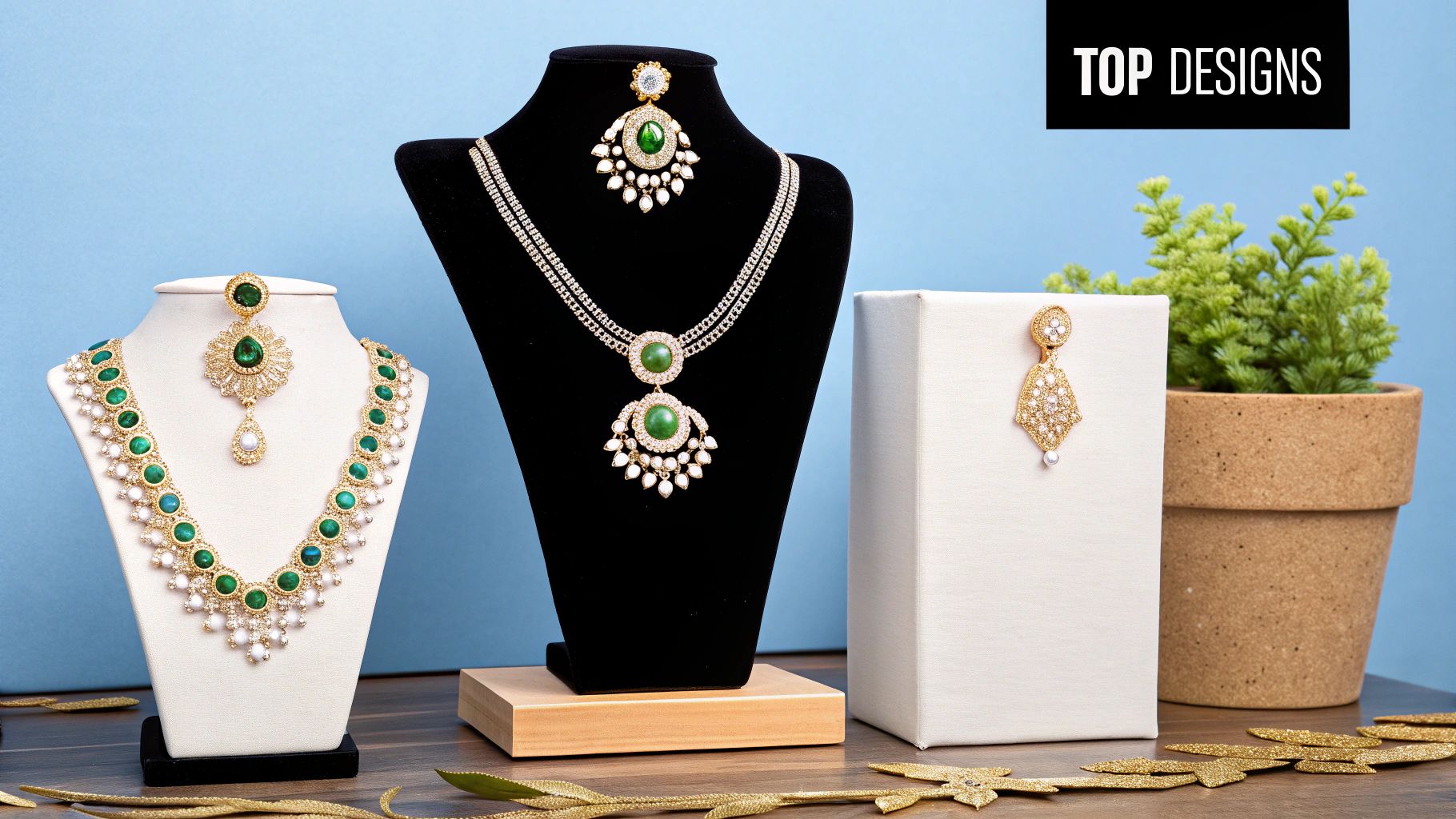Arthur Lynch | Sat Jul 26 2025
A Practical Guide to Sourcing Factory Direct Jewelry
Finding the perfect jewelry piece is one thing, but discovering it at a price that significantly boosts your bottom line is another. What if you could bypass the usual markups and access unique designs your competitors can't? This isn't just a possibility; it's the strategic advantage of buying factory direct jewelry.
This guide provides actionable steps to skip the traditional middlemen—wholesalers, distributors, and importers—and buy straight from the source. For any serious jewelry retailer or brand, this approach is a powerful way to increase profitability and control.
Why Going Straight to the Factory Just Makes Sense
Think of it like buying produce. You can get it from a high-end grocery store, or you can go directly to the farmer's market. Both get you an apple, but one is fresher, less expensive, and you can talk to the person who grew it. That's the core principle of factory-direct sourcing. It rewires the economics of your jewelry business.
The most immediate win is cost savings. By eliminating layers of markups, you can secure prices 15-30% below standard wholesale. For a business owner, this isn't just extra cash; it's capital for marketing, inventory expansion, and new product development.
It's About More Than Just the Price Tag
While cost reduction is a major driver, the true power of working directly with a factory is the control it gives you. You transition from being just another customer to a partner in the creation process.
- Implement Your Quality Standards: Communicate directly with the people making your pieces. Specify the exact materials, plating thickness, and stone grades you require. This is your opportunity to build quality into your products from the ground up.
- Access an Unseen Catalog: Factories often have a vast library of designs that are not available on the open market. A direct relationship gives you a key to this hidden inventory, providing a source of unique products.
- Execute Your Vision: Most manufacturers are equipped for customization. Provide a sketch or a clear brief to modify an existing design or create an entirely new piece. This is how you translate your brand's unique vision into tangible, sellable products.
This direct communication creates a level of transparency you can't get from a distributor. You’re not just ordering a product; you’re overseeing its creation.
Actionable Insight: Don't just accept a factory's standard offerings. Prepare a detailed spec sheet for every order, outlining your exact requirements for materials, dimensions, and finishing. This transforms a simple purchase into a powerful strategic advantage for your business.
A Smart Move in a Booming Market
Sourcing directly isn't just a cost-cutting trick; it’s a strategic imperative in today's market. Modern consumers are informed. They demand authenticity, want to know where their products come from, and are constantly looking for value.
The global jewelry market is projected to hit a staggering $348 billion in 2025. In a market this large, your competitive edge comes from offering unique, high-quality jewelry at a compelling price. If you want to dive deeper, you can find more details on these jewelry industry statistics to see the full scope of the opportunity.
How to Find the Right Jewelry Factory
So, you’re ready to find a factory partner. The key is to move beyond a simple Google search and adopt a multi-channel strategy. This approach will help you build a solid list of potential partners and sidestep the overcrowded and often less reliable suppliers.
Most searches begin on large B2B platforms. While there's nothing wrong with starting on well-known sites like Alibaba or industry-specific suppliers like Stuller, using them effectively requires a strategic approach.
Mastering B2B Platform Searches
Your first move is to filter for suppliers with established credentials. Look for labels like “Verified Supplier,” “Gold Supplier,” or those with a long business history—a minimum of five years is a good benchmark. These badges indicate that the platform has performed some level of vetting, giving you an initial layer of security.
Next, refine your keywords. Broad searches are a waste of time. Instead, use specific, long-tail keywords that describe exactly what you need.
- Instead of "silver ring factory," search "925 sterling silver minimalist ring manufacturer."
- Swap "gold necklace wholesale" for "18k gold vermeil custom necklace supplier."
- Use precise terms like "Lab-grown diamond tennis bracelet factory direct" to find specialists.
This focused technique cuts through the noise of general resellers and connects you with factories that specialize in the products you want to build your brand around.
Comparing Popular Jewelry Sourcing Platforms
To get you started, here’s a quick breakdown of top platforms. Choose the one that best aligns with your business goals and order volume.
| Platform | Best For | Key Advantage | Actionable Tip |
|---|---|---|---|
| Alibaba | High-volume orders and finding a wide variety of manufacturers. | Massive selection and competitive pricing due to high competition. | Filter for "Verified" and "Trade Assurance" suppliers. Start with a small sample order. |
| Global Sources | Finding established, export-focused suppliers for premium goods. | Tends to have more verified, experienced manufacturers than Alibaba. | Use for higher-end products; be prepared for higher MOQs. |
| JewelryBund | Small to mid-sized businesses looking for trendy, ready-to-ship fashion jewelry. | Low MOQs and a focus on current trends, making it easy to test new styles. | Ideal for market testing. Buy small quantities of several styles to gauge demand. |
| Stuller | Jewelers in North America needing high-quality findings, metals, and stones quickly. | Extremely fast shipping (often overnight) and impeccable quality control. | Best for components and just-in-time supplies, not bulk overseas manufacturing. |
Using a mix of these platforms can give you a more rounded view of the market. Start with one that aligns with your immediate goals, but don't be afraid to explore others as your needs evolve.

Sourcing directly from the factory is a fundamental strategy for building a more profitable and sustainable jewelry business from the start.
Beyond the Search Bar: Uncovering Hidden Gems
While platforms are an excellent starting point, some of the best manufacturing partners are found through more direct methods. These require more detective work but can yield significant rewards.
One effective tactic is to reverse-engineer popular designs. See a trending style on social media or in a boutique? Try to trace it back to the source. Look for watermarks on images, check for manufacturing details on competitor websites, or use a reverse image search. This can often lead you straight to the OEM (original equipment manufacturer) producing for multiple brands.
Actionable Insight: The most reliable factory relationships often come from community referrals and targeted networking. Actively ask for recommendations in online forums and professional groups. A referral from a trusted peer is more valuable than any online rating.
Tap into the power of niche communities. Join jewelry-making forums, LinkedIn groups for jewelry professionals, or Facebook groups for small retail business owners. People in these spaces are often willing to share their experiences and recommendations.
For a deeper dive into building these crucial relationships, our guide on navigating the B2B jewelry market offers more strategies. By combining smart digital searches with genuine networking, you’ll build a robust list of potential partners.
Vetting Factories to Avoid Costly Mistakes

You have a list of potential manufacturers. Now comes the most critical phase: vetting. This is where you separate true partners from expensive headaches. Rushing this stage is a recipe for disaster, leading to shoddy products, missed deadlines, and lost money.
Treat this process like hiring a key employee. You wouldn't hire someone without a thorough interview and reference check. Apply the same rigor here. Your job is to dig past the sales pitch to verify their operations, communication, and commitment to quality.
Decoding Certifications and Verifying Claims
Any factory can claim to be the best, but legitimate certifications provide proof. When a supplier claims they are certified, ask to see the documentation. In the jewelry industry, two certifications are particularly meaningful:
- Responsible Jewellery Council (RJC): This is the gold standard. An RJC certification indicates the factory adheres to strict ethical, social, and environmental standards, including conflict-free sourcing.
- ISO 9001: This certification focuses on quality management systems. It means the factory has documented, repeatable processes to ensure consistent product quality—a significant advantage for you.
If a factory is hesitant to share proof, consider it a major red flag. Reputable manufacturers are proud of these credentials. This due diligence is critical as the global jewelry market, projected to grow at a CAGR of 5.10% between 2025 and 2032, sees increasing consumer demand for transparency. You can learn more about the growth of the jewelry market to understand the importance of ethical sourcing.
Asking the Right Questions
Your initial contact should be a structured interview, not a casual chat. Prepare a list of specific questions to test their expertise and honesty.
Here are a few essential questions to ask:
- What is your production capacity and the typical lead time for an order of [your estimated quantity]? This immediately tells you if they can handle your volume and meet your deadlines.
- Can you walk me through your material sourcing process? Where do your metals and gemstones come from? Press for details. Ask if they use recycled metals or can provide documentation for conflict-free stones.
- What does your quality control process look like in practice? Have them explain the specific checkpoints a piece goes through from raw material to final packaging.
- Can we schedule a virtual factory tour? A supplier willing to show you their workspace over a video call demonstrates transparency and confidence in their operations.
Actionable Tip: Pay close attention to how they answer. Are their responses quick, detailed, and confident, or are they slow and evasive? The quality of their communication is often a direct reflection of their operational standards.
The Sample is Your Ultimate Test
After narrowing your list, it's time to order samples. This step is non-negotiable. A physical sample is the ultimate proof of their craftsmanship.
When the samples arrive, conduct a thorough inspection.
Compare the physical piece to the CAD designs and photos. Check the weight, plating thickness, clasp functionality, and stone settings. Is everything exactly as specified? A minor flaw in a sample will become a major defect in a bulk order.
If you’re new to this, our guide on what to look for in jewelry manufacturing offers a detailed checklist to help you evaluate quality like a pro.
Investing a small amount upfront for samples from your top two or three factories is the smartest money you'll spend. It allows you to compare quality side-by-side and make a final, data-driven decision about who will produce your factory direct jewelry.
Talking Terms: How to Negotiate Your First Factory Order
Negotiation is not a confrontation; it's a collaborative process to establish a strong working relationship. Getting the terms right from the start ensures a smoother partnership.
The first common hurdle is the Minimum Order Quantity (MOQ). Factories have MOQs to cover their setup costs, but they don't have to be a dealbreaker. If a factory's MOQ is 500 pieces per design and you only want to order 100, open a dialogue. Propose paying a slightly higher price per piece for the smaller run. This shows you respect their costs and are a serious partner, increasing their willingness to be flexible.
Getting the Numbers Right
After agreeing on quantity, focus on pricing and payment terms. While the unit price may have some flexibility, the payment structure is fairly standard. The most common is the 30/70 split.
You pay 30% of the total order value upfront to fund raw materials and start production. The final 70% is due upon order completion and successful inspection, but before the goods are shipped. This system provides security for both parties.
My Two Cents: If a potential supplier demands 100% payment upfront on a first order, politely decline and walk away. A 30/70 or 50/50 split demonstrates a partnership built on mutual trust, not a blind risk.
The Purchase Order Is Your Bible
While emails are useful, your Purchase Order (PO) is the legally binding contract. If a detail isn't in the PO, it doesn't exist. Ambiguity is your enemy and can lead to costly mistakes.
Your PO must be meticulously detailed.
- Designs & Dimensions: Attach professional CAD files with every measurement clearly labeled.
- Materials Breakdown: Be specific. Instead of "silver," write "925 Sterling Silver." Call out every component, like "Grade AAA freshwater pearls."
- Plating & Finishing: "Gold plated" is too vague. Specify the thickness and type, such as "1.5 microns of 18k gold vermeil over sterling silver with a high-polish finish."
- Branding: Include instructions for logo stamping or custom tags, specifying placement and size.
This level of detail eliminates guesswork and ensures you and the factory are perfectly aligned.
Keeping Your Designs Yours
To protect your original designs, you need to secure your intellectual property (IP). A simple Non-Disclosure Agreement (NDA) is a good first step. At a minimum, include a protective clause directly in your Purchase Order.
A simple sentence stating that the designs are your exclusive property and the manufacturer agrees not to sell, share, or reproduce them for any other party is often sufficient. This establishes a professional boundary and helps safeguard your brand's unique identity.
Managing Production and Quality From a Distance

Placing your order is just the beginning. The next step is to ensure the jewelry produced thousands of miles away matches your exact specifications. Effective remote production management relies on a system of clear communication and verification.
Before production begins, agree on a schedule for progress updates. Request weekly check-ins with high-resolution photos and videos. This isn't micromanagement; it’s a smart collaboration that allows you to catch minor issues before they become major problems.
Building Trust Through Verification
Progress shots are useful, but for final approval, you need an unbiased evaluation. A third-party inspection service is an invaluable asset. For a reasonable fee, these services send a trained professional to the factory to act as your representative.
Their review is based on your purchase order and typically includes:
- Verifying Materials: Confirming the correct metals and gemstones were used.
- Checking Dimensions: Measuring pieces against your CAD files for precision.
- Inspecting Craftsmanship: Scrutinizing clasps, settings, and polish quality.
- Confirming Quantity: Conducting a full count to ensure the shipment is complete.
This impartial report gives you the confidence to approve the shipment and release the final payment. This is a non-negotiable step for any order, from fashion jewelry to high-end collections.
The global luxury jewelry market is booming, with a projected value of around $57.13 billion by 2025. In this valuable market, the factory direct jewelry model is a game-changer. Direct oversight, backed by third-party verification, is how you guarantee the quality and ethical sourcing that luxury customers demand. You can learn more about the dynamics of the luxury jewelry market to see the full scope of the opportunity.
From Production to Your Doorstep
Once the inspection report is approved, it’s time to manage the final logistics. The factory will pack the order for shipping according to the agreed-upon terms (e.g., FOB or EXW). From there, your freight forwarder or customs broker will handle transportation and import.
By implementing this system—clear communication, regular updates, and independent final inspection—you remove the guesswork from overseas manufacturing. You create a repeatable process that ensures the factory direct jewelry arriving at your door meets your standards, every single time.
Your Factory Direct Jewelry Questions Answered
Diving into direct sourcing is exciting, but it's natural to have questions. Even experienced buyers encounter challenges. Let’s tackle some of the most common concerns for those new to buying factory direct.
How Do I Handle International Shipping and Import Duties?
This comes down to clear communication from the start. First, discuss Incoterms with your factory. These are standard trade terms like FOB (Free on Board) or EXW (Ex Works) that define who is responsible for shipping costs and when. Get this agreement in writing.
For customs, the most effective action is to hire a customs broker. Don't try to navigate this complex process alone. For a small fee, a broker handles all paperwork, calculates the exact duties and tariffs owed, and ensures your shipment clears customs without delays. It is a worthwhile investment.
What if the Final Products Don't Match the Sample?
This is a valid concern that can be managed proactively. Your detailed purchase order (PO) and a pre-shipment inspection are your primary tools for prevention. Your PO is a binding contract outlining every product detail. If the final shipment does not match the PO, you have a solid basis for requesting a refund or a remake.
Actionable Tip: Think of a third-party inspection service as your insurance policy. They are your eyes and ears at the factory, identifying problems before you send the final payment and the goods leave the country. This turns a potential crisis into a manageable issue.
Taking this step is what separates amateurs from professionals. It ensures the product you approved is the product you receive.
Are B2B Platforms Like Alibaba Safe for Buying Jewelry?
Yes, they can be, provided you do your due diligence. Vetting a supplier's profile is crucial.
Here is a checklist of what to look for:
- Trust Badges: Prioritize suppliers with "Verified" or "Gold Supplier" status, as this indicates some level of background check by the platform.
- Company History: A supplier with 5+ years of history on the platform is generally a safer choice than a new account.
- Real Reviews: Read both positive and negative reviews to get a balanced understanding of their quality and communication.
Most importantly, always use the platform's secure payment system, like Alibaba Trade Assurance, for your transactions. This provides a clear dispute resolution path. For a complete checklist, our guide on evaluating online jewelry suppliers breaks down the entire process. A final piece of advice: never pay a new supplier with a direct wire transfer for your first order. You will have no recourse if something goes wrong.
Ready to source with confidence? At JewelryBuyDirect, we connect you with certified manufacturers and handle the logistics, so you can focus on growing your business. Explore over 120,000 trend-driven designs with no minimum order requirements and save 15-30% below market prices. Visit us today!



 to show code
to show code



































































































































